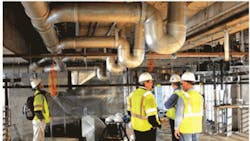Stainless-Steel Drainage Piping Chosen for new Jail Kitchen/Warehouse Facility
On Aug. 28, 2005, as Hurricane Katrina hammered the coast of Louisiana, the levee system in New Orleans failed, and 80 percent of the city and large tracts of neighboring parishes were flooded with sewage-rich seawater.
One of the challenges presented by the swelling floodwaters concerned the evacuation of thousands of prisoners from the downtown Orleans Parish prison system. All 12 jail facilities were overrun by floodwaters, with most tagged as “totally destroyed” in the hurricane’s wake.
Today, construction of permanent, greatly more storm-resistant jail facilities is under way.
“We’re now moving beyond recovery and into rebuilding,” Parish of Orleans Sheriff Marlin Gusman said.
Started in March 2010 is an $80 million, three-story, 164,000-sq-ft food-preparation and storage facility. The building has the capacity to serve 25,000 meals every 12 to 14 hr and preserve prepared meals for up to 45 days.
Stainless Makes the Grade for High-Temperature Plumbing
For 8,000 lineal feet of drainage piping, the general contractor, New Orleans-based Woodward Design+Build, chose stainless-steel pipe supplied by Blücher, a Watts Water Technologies Inc. company.
“Due to its hardness and very low porosity, bacterial growth is greatly reduced,” Jamey Logrande, vice president and senior project manager for Metairie, La.-based Huseman & Associates, recipient of a 2009-2010 regional ASHRAE Technology Award for its design of the building’s electrical, mechanical, plumbing, and fire-protection systems, said, “and, of course, the very nature of this building—within the harshest of environments—is to assure permanence and durability.”
Stainless steel is a pressure-, corrosion-, and chemical-resistant material with a life expectancy six to 12 times greater than that of cast iron in a commercial-kitchen setting. Because of stainless steel’s material properties, the weight of a drainage system can be more than 20 percent lower than with cast iron.
Two 300-hp Hurst steam boilers are dedicated to kitchen heat for cooking and dishwashing. In the kitchen, a bank of 300-gal. kettles, two 60-gal. kettles, and a 1,000-gal. cook tank are used to cook food.
“We needed a plumbing system that could routinely move liquids at temperatures of up to 250°F to 260°F because of the multiple 300-gal. steam pressure cookers dumping into the waste system,” Logrande said.
“Stainless-steel gaskets are rated for use at temperatures of up to 390°F,” Logrande explained. “And we needed to exceed the rated maximum temperatures for cast-iron couplings and gaskets: just 210°F.”
In addition to temperature, weight and volume were of concern.
“A key advantage to the stainless steel is its greater tolerance for transportation of fat, and with most of the drainage piping emptying into a 10,000-gal. grease trap, it’s clear that there’s an expectation for loads of the stuff, which, as it cools, quickly congeals and can become a very tough obstacle to fluids in the pipeline,” Mike Billingsley, president of Kenner, La.-based Billingsley and Associates Inc., manufacturer’s representative for Watts Water Technologies and Blücher, said.
The facility features two independent waste systems for grease. The primary system, which dumps immediately into a 400-gal. automatic grease-removal unit from Highland Tank & Manufacturing Company Inc., was built to handle the heavy grease load. The secondary system will manage the rest of the kitchen (sinks, dishwashers, etc.).
At several points, the grease-waste piping is flushed with hot water.
“This is to be sure that no residual grease, rice, and pasta are trapped,” Logrande said. “The hot-water flushing is activated several times a day by the building automation system.”
Philip Chauffe, project manager for Metairie-based Gallo Mechanical LLC, which was contracted to install all plumbing and mechanical systems, said transportation of fatty liquids to and through the giant grease trap is a key reason stainless-steel pipe, used in 2-in. to 8-in. sizes, was chosen.
“About half of the stainless-steel pipe is heat-traced with an electric-cable heat element that was attached to the entire length of the pipe wall and then wrapped with 1-in. fiberglass insulation,” Chauffe said.
With the anticipated heat loss, if cast iron had been used, the risk of fat collection, coagulation, and clogging along pipe interior walls would be high, Chauffe said.
“There’s far less risk of that with stainless steel,” Chauffe said.
Heat tracing was added as relatively low-cost insurance.
Better Infrastructure = Greater Security
A key component of the plan for the kitchen/warehouse facility is the ability to manage expansion with smart infrastructure systems at the central plant.
“They can now operate the food service, central warehouse, and mechanical systems for all the other structures from that framework,” Ken Ball, a corrections specialist with the sheriff’s office, said. “It’s an opportunity rarely seen by a large urban correctional system.”
John Vastyan is owner of Common Ground, a Manheim, Pa.-based communications firm focused on the plumbing-and-mechanical, HVAC, geothermal, and solar- and radiant-heat industries.
For Design Solutions author guidelines, call Scott Arnold, executive editor, at 216-931-9980, or write to him at [email protected].
